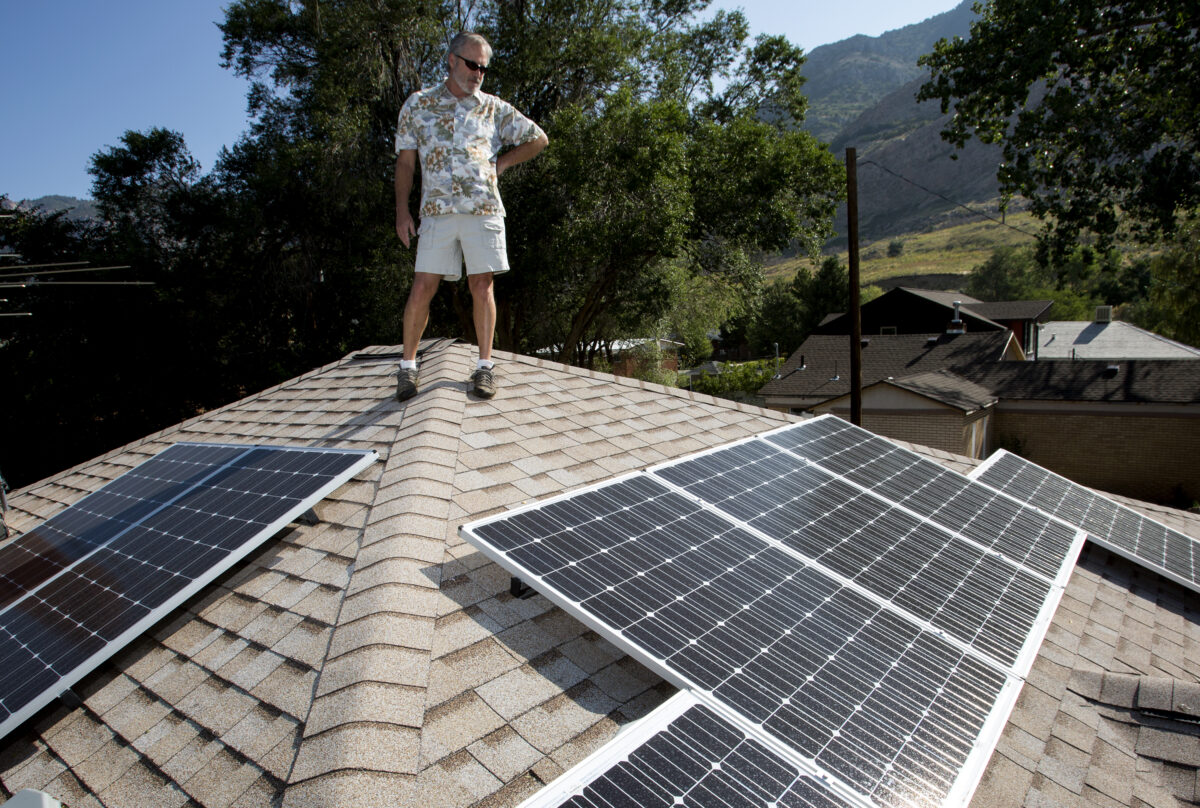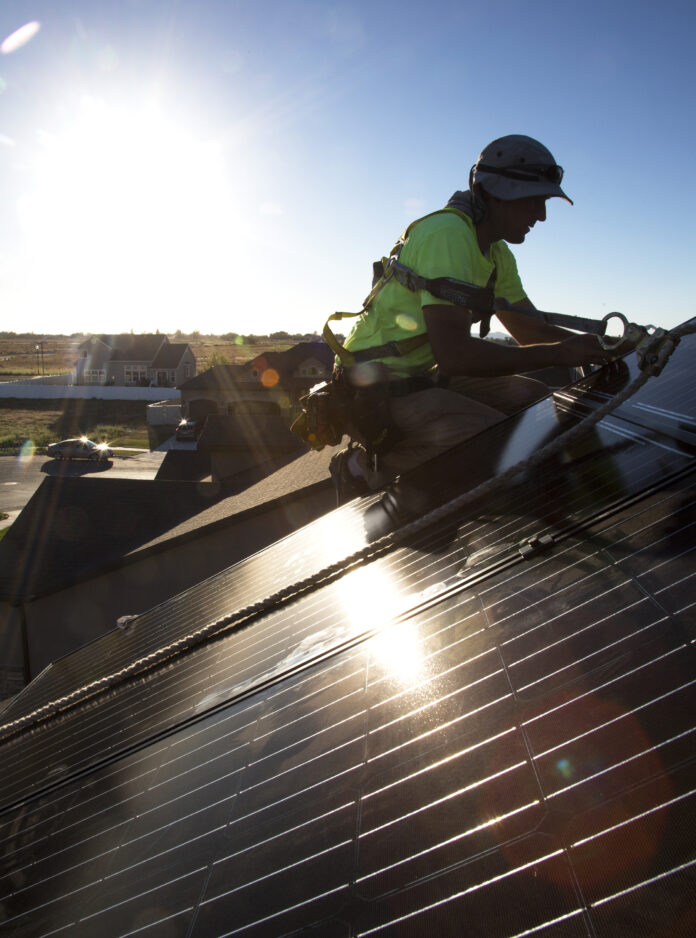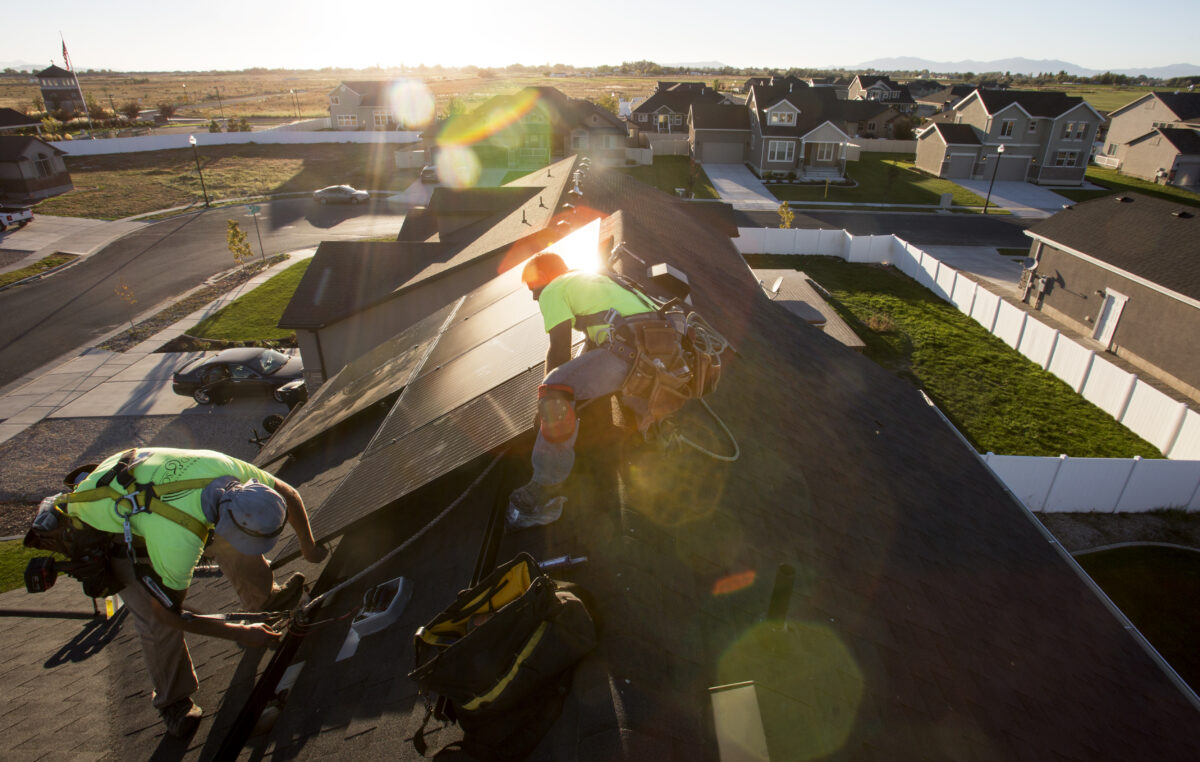Rocky Mountain Power proposes new rates for rooftop solar customers
CORRECTION: An earlier version of this story misquoted the proposed rates. We regret the error.
Utah’s largest power utility wants to bump up electric rates for those with solar panels, but the change will likely be a tough sell.
Rocky Mountain Power and other electricity providers throughout the nation have grappled with a surge in rooftop solar customers and how to best diffuse the toll they take on the grid. Around a decade ago, when panels were still relatively expensive to purchase and install, many utilities turned to net metering. That billing system allows solar customers to sell excess power from their panels back to the grid. It also offsets their costs when the sun sets and they have to draw power from the utility again.
Net metering created an added incentive for customers to install rooftop panels, too, since it brought a return on their investment in a solar system. But dropping price tags for solar panels a rise in solar installations means utilities are now scrambling.
“We knew it’d be an issue that got worse if we didn’t deal with it,” said Paul Murphy, spokesman for Rocky Mountain Power.
On Wednesday, PacifiCorp, Rocky Mountain Power’s parent company, submitted a net metering study and updated cost proposal to the state. Under their proposed change, existing solar customers will be grandfathered in, paying existing electric rates and receiving the same benefits from the grid.
For new solar customers, starting Dec. 9, 2016, Rocky Mountain Power proposes the following changes:
- A customer charge that will rise from $6 to $15.
- A one-time $60 fee for small solar panel installations, and a $75 to $150 fee for larger systems.
- A charge of $9.02 per kilowatt during high demand periods.
- A 3.81 cents per kilowatt-hour charge for energy used.
Solar customers currently pay 8.50 to 14.50 cents per kilowatt hour, like non-solar customers, depending on time of year and their usage. But bills for rooftop solar customers under will jump under the new net metering proposal.
Rocky Mountain Power calculates the average solar customer pays $55 a month. The new rate would take that bill to $74, but customers will still pay less than the average non-solar customer, who pays $114 monthly.

Rocky Mountain Power
In a recent net metering study submitted to the Utah Public Service Commission, Rocky Mountain Power argued the growth of rooftop solar customers created unfair costs to regular power users. Graph is from the study, “In the Matter of the Investigation of the Costs and Benefits of PacifiCorp’s Net Metering Program,” submitted Nov. 9, 2016.
’Crippling’ costs or sharing the system?
The proposal received a murky response from solar advocates Wednesday. HEAL Utah, which often acts as an environmental watchdog group over Rocky Mountain Power, released a statement calling the proposal an “attack on solar.”
“Rocky Mountain has made its intentions crystal clear today: It’s trying to make solar unaffordable for Utah families, in a bid to kill of a disruptive industry that is beginning to threaten its profits,” Matt Pacenza, HEAL Utah’s Executive Director, said in the statement.
HEAL Utah also cited concerns with increased electric rates that could deter new solar customers, since panel installation is already a sizable cost for most households. They called the $9.02 kilowatt charge for peak demand periods “crippling.”

BENJAMIN ZACK/STANDARD-EXAMINER
Travis Wood, left, and Daniel Fraga install solar panels on a home in Clinton on Monday, Oct. 12, 2015. Residents have had to battle with the home owners association, which is mostly controlled by Ivory Homes, in order to install panels on their own roof.
“Solar has become affordable recently to a wide range of Utah families,” Pacenza said. “That stops now. An investment that would pay off in a decade now will take 20 or 30 years before it pays back — if ever.”
Utah Clean Energy, which helped bring solar panels to hundreds of Northern Utah rooftops in 2015 through Weber State University’s Susie Hulet Community Solar Program, took a less aggressive stance. They noted the environmental benefits provided by solar panels, including lowered emissions from coal-fired power plants.
“I think we’re seeing utilities across the country begin to grapple with how to fairly compensate solar customers for the benefits they provide in the form of clean, price-stable energy,” said Kate Bowman, the organization’s solar project coordinator.
Utah Clean Energy is still trying to understand the Rocky Mountain Power proposal’s nuances before they take an official stance.
Rocky Mountain Power insists they have no beef with solar customers and that the proposal will not add extra profits to the utility’s bottom line. Instead, the measure is meant to keep rates fair for non-solar customers.

BENJAMIN ZACK/STANDARD-EXAMINER
New solar panels were installed on Jon Hinds and Karen Thurber’s Ogden with assistance from the Susie Hulet Community Solar Program at Weber State University. The program is designed to increase renewable energy in Weber, Davis and Morgan Counties.
“I think there’s a mistaken assumption that people with rooftop solar use system less, but actually they use it more,” Murphy said. “They’re not only taking (power) from the system but they’re giving it back. They rely on the grid more than anyone else.”
All the fees required to maintain the grid add up — from keeping power lines running to installing transformers to administrative costs. Each rooftop solar household essentially get a $400 subsidy each year, according to the utility’s study, which must be spread among remaining power customers.
Currently, it’s costing non-solar grid users $6.5 million annually to support rooftop solar. The utility forecasts that cost could grow to $78 million annually if solar’s popularity continues to grow and net metering rates don’t change.
Besides that, solar customers power consumption habits have shifted, which are taking a toll on the grid at large, too. Residential net metering customers tend to use more electricity at night as regular residential customers’ electricity use tapers off, according to the Rocky Mountain Power study, meaning they still put a lot of demand on the system.

Rocky Mountain Power
In a recent net metering study submitted to the Utah Public Service Commission, Rocky Mountain Power argued the growth of rooftop solar customers created unfair costs to regular power users. Graph is from the study, “In the Matter of the Investigation of the Costs and Benefits of PacifiCorp’s Net Metering Program,” submitted Nov. 9, 2016.
That’s why the utility is proposing a peak demand charge for solar customers.
“It’d change habits so it helps benefit other customers as well,” Murphy said. “You can think of it as, ‘how big of a pipe do we need to build to be sure you get the energy you need during those peak times?'”
The last word
The Utah Public Service Commission regulates for-profit utility monopolies like Rocky Mountain Power. They directed the utility to conduct the net metering study in November 2015, and the commission will ultimately decide whether Rocky Mountain Power’s proposal is approved.
Michele Beck director of the Utah Office of Consumer Services, was still poring over the 400-plus page document as of Wednesday morning. She remains neutral on the proposal for now.
“We’ll evaluate it carefully from a legal policy and analytical perspective, then we’ll come up with our position – which parts we support, which we oppose and which we want modified,” she said.
Still, Beck said net metering needs to be re-evaluated and adjusted for the benefit of all electric customers in the state.
“I actually do agree that residential net metering customers are not paying their fair share of the costs,” she said. “But I’m concerned, because in other jurisdictions, I think utilities have tired to really shift more costs than are justified … what we want to evaluate is that everyone pays their fair share.”
Contact Reporter Leia Larsen at 801-625-4289 or llarsen@standard.net. Follow her on Facebook.com/leiaoutside or on Twitter at @LeiaLarsen.






